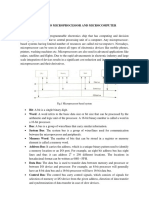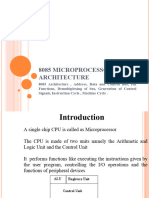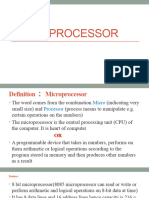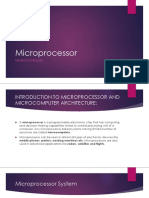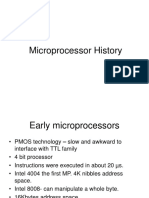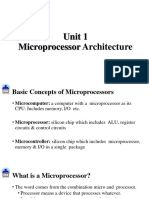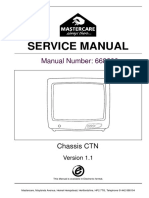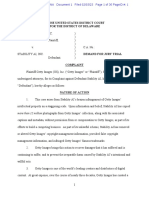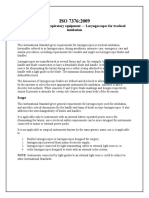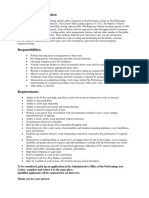⛳
Microprocessor Architecture
Type Module
Reviewed
Revision 25% 50% 75%
Introduction
💡 A microprocessor is a multipurpose, programmable logic device that
reads binary instructions from a storage device called memory ,
accepts binary data as input and processes data according to those
instructions and provides results as output. Microprocessor
incorporates the functions of a computers CPU on a single IC .
Whereas the Microcontroller are the silicon chip which includes
microprocessor , memory and I/O in a single package.
Processor means a device that processes numbers , specifically binary
numbers , 0’s and 1’s.
Components :
1. Hardware : physical components
2. Software : set of instructions called software
MEMORY :
They are like pages of of notebook with space for binary numbers , pages
are made of semiconductor materials .
Microprocessor Architecture 1
� Each Line is a 8 bit register that can store 8 bits and several of these
registers are arrayed in sequence called memory.
A group of 1024 (2^10) 8 bit registers on a semiconductor is known as 1K
byte of memory.
Organization of a microprocessor based system :
Registers or Arrays
Stores data temporarily during the execution of a program
Input and Output Devices
Also known as peripherals : keyboards , switches, ADC ,LED CRO , DAC
System Bus
Communication path , a group of wires to carry bits.
Control Unit
Microprocessor Architecture 2
� Provides necessary timing and control signals to all the operations ,
control the flow of data between microprocessor and memory and
peripherals.
Memory
memory is a physical device that stores data and information
ROM :
ROM is the part of memory that is usually preloaded with information
and software.
CPU can only read from it and it cannot be changed .
Stores computers initial starter instructions and it can even retain data
when switched off.
RAM :
Random Access Memory is volatile. That means data is retained in RAM
as long as the computer is on, but it is lost when the computer is turned
off.
MICROPROCESSOR ARCHITECTURE AND ITS
OPERATION :
MPU performs 4 operations :
1. Memory read : reads data or instructions from the memory
2. Memory write : Writes data or instructions to memory
3. I/O Read : Accepts data from Input devices
4. I/O Write : Sends data to the output devices
Tow Communicate with a peripheral or memory , MPU must perform
following steps
1. Identify peripheral or memory locations.
2. Transfer data
3. Provide timing or synchronization signals .
The MPU performs these functions using three set of communication lines ,
they are called buses.
Microprocessor Architecture 3
� Address Bus
group of 16 unidirectional lines [ A0 to A15].
They are used for identifying of memory locations
2^16 = 65536 memory locations [ 64 KB of memory]
Data Bus
group of 8 bidirectional lines [ D0 to D7] for data transfer.
It can manipulate 2^8 = 256 [ from 00 to FF ]
Control Bus
Single lines that carries synchronizing signal
Used to provide timing signal
Illustrations :
To read an instructions(data) from a memory locations
STEPS
Microprocessor Architecture 4
� MPU places the 16bit address on the address bus
Address is decoded by an external logic circuit [ Memory decoder].
Memory locations is identified.
MPU sends a pulse called “Memory Read” as control signal and the
pulse activate the memory chip.
Contents of the memory locations are placed on the data bus and
brought inside the MPU.
Internal data operations :
store 8 bit data
performs arithmetic and logical operations
Test the conditions
Sequence the execution of instructions
Store date temporarily during execution
8085 Registers :
To perform any operations , the MPU needs
Registers
An Arithmetic and logic unit [ ALU ]
Control logic
Internal Buses [ paths for information flow ]
Registers
8085 has six general purpose registers — B,C,D,E,H,L of 8 bits each to
store 8 bit data
Register pairs — BC , DE and HL to perform 16 bit operations. These are
programmable registers.
Microprocessor Architecture 5
� Accumulator (A) :
It is 8 bit register which is part of ALU
It is store 8 bit data and the result of a operations is stored in accumulator.
In an arithmetic operation involving two operands, one operand has to be in
this register. And the result of the arithmetic operation will be stored or
accumulated in this register
General purpose register :
MPU 8085 has 6 general purpose register , each have 8 bit and also
programmable
They can be used as register pair , BC , DE, HL used for 16 bit data
Flags :
ALU includes 5 flip flops to set or reset according to data conditions in the
accumulator and other registers .
They are not used as 8 bit registers : Zero(Z) , Carry (CY) , Sign(S) , Parity
(P) and Auxiliary Carry (AC).
Flags are stored in 8 bit register so that the programmer examine these
flags by accessing the register through an instruction.
Program Counter (PC) :
16 bit register
sequencing the execution of instructions
Microprocessor Architecture 6
� The function of the PC is to point to the memory address from which the
next byte is to be fetched ,
When a byte is being fetched , the PC is incremented by one to point to the
next memory location .
Stack Pointer (SP) :
16 bit register
Memory pointer
Points to a memory locations in R/W memory called the stack.
The beginning of the stack is defined by loading a 16 bit address in the
stack pointer
Externally initiated operations :
External devices can initiate the following operations - Reset , Interrupt ,
Ready , Hold .
1. Reset : when activated , all internal operations are suspended and PC is
cleared ( It hold 0000 H)
2. Interrupt : It can be interrupt from the normal execution of instructions and
asked to execute some other instructions , called service routine , after that
it resumes its normal operations
3. Ready : if low , MPU enters into a wait state , this signal is used primarily to
synchronize slower peripherical with MPU .
4. Hold : If activated , the MPU relinquishes control of buses and allows the
external peripheral to use them.
8085 Microprocessor :
8085 MPU is an 8 bit general purpose microprocessor
Capable of addressing 64KB of memory
It has 40 pins and it requires a +5 V supply
Can operate with a 3 MHz single phase clock
Microprocessor Architecture 7
� All the signals can be classified into six groups —
1. Address Bus
2. Data bus
3. Control and Status Signals
4. Power Supply and Frequency signals
5. Externally initiated signals
6. Series I/O ports
Introduction to 8085 Instructions :
The 8085 is an 8 bit device it can have up to 2^8 (256) instructions.
However, It uses 246 combinations that represent a total of 74 instructions
These instructions can be grouped into five different groups :
Data Transfer Operations
Arithmetic Operations
Logic Operations
Branch Operations
Machine Control Operations
Each instructions has two parts.
1. The first part is the task or operations to be performed . It is called
“OPCODE”.
2. The second part is the data to be operated on . It is called “OPERAND”.
Microprocessor Architecture 8
� Data Transfer Operations :
These operations COPY data from the source to the destinations ,
MOV , MVI , LDA and STA
They transfer :
Data between registers.
Data Byte to a register or memory locations
Data between memory locations and a register
Data between an I/O device and the accumulator.
The Data in the source is not changed.
The LXI instructions : ( Load Extended Immediate )
The 8085 provides an instructions to place the 16 bit data into the
register pair in one step.
💡 LXI Rp, < 16-bit address >
The instructions LXI B 4000H will place the number 4000 into the
register pair B,C
The Memory “Register”
Most of the instructions of the 8085 can use a memory locations in place of
a register
Microprocessor Architecture 9
� 💡 MOV M B //copy the data from register B into a memory location.
The 16 bit contents of the HL register pair are treated as 16 bit address and
used to identify the memory locations.
There is also an instructions for moving data from memory to the
accumulator without disturbing the contents of the H and L register.
💡 LDAC Rp { Load Accumulator Extended }
ARITHMETIC OPERATIONS:
Additions (ADD,ADI) and Subtractions (SUB, SUI):
Any 8 bit number can be added to the contents of the accumulator and the
result is stored in the accumulator.
Can be subtracted from the contents of the accumulator . The result is
stored in the accumulator
ADD M //add the contents of M to the accumulator
SUB M //sub the contents of M from the accumulator
INR M / DCR M //Increment/ decrement the content of the M in place
// 8 Bit content can be incremented/ Dec by 1.
/*All of these use the contents of the HL register pair to identify the
memory locations being used */
It is possible to manipulate a 16 bit address stored in a register pair as one
entity using some special instructions.
💡 INX/DCX Rp { Increment/decrement the 16 bit number in the register
pair }
LOGIC OPERATIONS :
Microprocessor Architecture 10
� These instructions perform logic operations on the content of the
accumulator ANA, ANI , ORA , ORI , XRA and XRI
ANA R/M // AND Accumulator with reg/ mem
ANI # // AND Accumulator with an 8 bit number
ORA R/M // OR Accumulator with Reg/mem
ORI # // OR Accumulator with an 8 bit number
XRA R/M //SAME just XOR
XRI # //SAME
CMA // 1s complement of the contents of the accumulator
Rotate :
Rotate the content of the accumulator one position to the left or right.
RLC : Rotate the accumulator left
RAL : Rotate the accumulator left through the carry
RRC/RAR for right.
COMPARE
Compare the contents of the register or memory locations with the contents
of the accumulator.
CMP R/M : Compare between registers and memory locations
Microprocessor Architecture 11
� CPI # : For numbers
The compare instructions sets the flags ( Z, CY and S )
Branch Operations :
Types :
1. Unconditional branch : Go to a new locations no matter what
2. Conditional branch : Go to a new locations if the condition is true.
JMP Address //Jump to the address specified
CALL address //Jump to the address specified but treat it as a subroutine
RET // Return from a subroutine
/* The addresses supplied to the branch operations must be 16-bits */
JZ Address //Jump on Zero [ Go to the specified address if the zero flag is set
JNZ Address //Jump on NOT CARRY
JC Address // Go to the specified locations if the carry flag is set
JNC Address // Jump on No Carry
JP Address //Jump on Plus [same just sign flag]
JM address // Jump on Minus
Machine Control :
💡 HLT : Stop the executing the program NOP: No operations , exactly as
it says , do nothing
Typically all instructions occupy one byte only . The exceptions is any
instruction that contains immediate data or a memory address.
Instructions that include immediate data use two bytes and memory
address occupy three bytes.
Microprocessor Architecture 12
�Microprocessor Architecture 13


















